|
"WIED, GUSTAV.
Egenhændigt brev til Hr. Juncker. Dateret 22-11-8.
Kastellet, Roskilde, 1908. Lille 4to. 2 sider. Omhandler afregninge af royalties for tyske og østrigske opførelser, forsinkelser i disse - er teatret ved at gå fallit ? - om opførelser i Wien, om oversættelser af ""Dansemus"" - ""Jeg har lavet en virkningsfuld Drejesceneudgave af Dansemus"" etc. etc.
Bookseller reference : 51024
|
|
|
"WIED, GUSTAV.
Egenhændigt brev til Hr. Juncker. Dateret 22-8.07.
Kastellet, Roskilde, 1907. Lille 4to. 2 sider. Juncker har ikke afregnet salg af Wieds bøger hurtigt nok, både overfor Gyldendal og overfor ham selv. Wied laver regnestykker over gælden og slutter brevet med ""...men samtidig vil jeg ikke undlade at fortælle Dem, hvor meget Deres, ja skal vi sige: Distraktion i Forretningssager pine mig. Herregud, at De ikke kan spare baade Dem selv og mig for alle de enerverende Ubehageligheder.""
Bookseller reference : 51026

|
|
|
"WIED, GUSTAV.
Egenhændigt brev til Hr. Hagelin. Dateret 7 Febr. 96.
Villa Rolykke ved Sæby Jylland Danmark, 1896. Lille 4to. 1 1/2 side. Wied har skrevet en atikel om Celle i Politiken - denne er faldet Hagelin for brystet, han har følt sig stødt. Wied forsøger at (bort)forklare og ender brevet med ""I hvert Tilfælde beder jeg Dem ikke huske paa mig med Uvilje.""
Bookseller reference : 51027
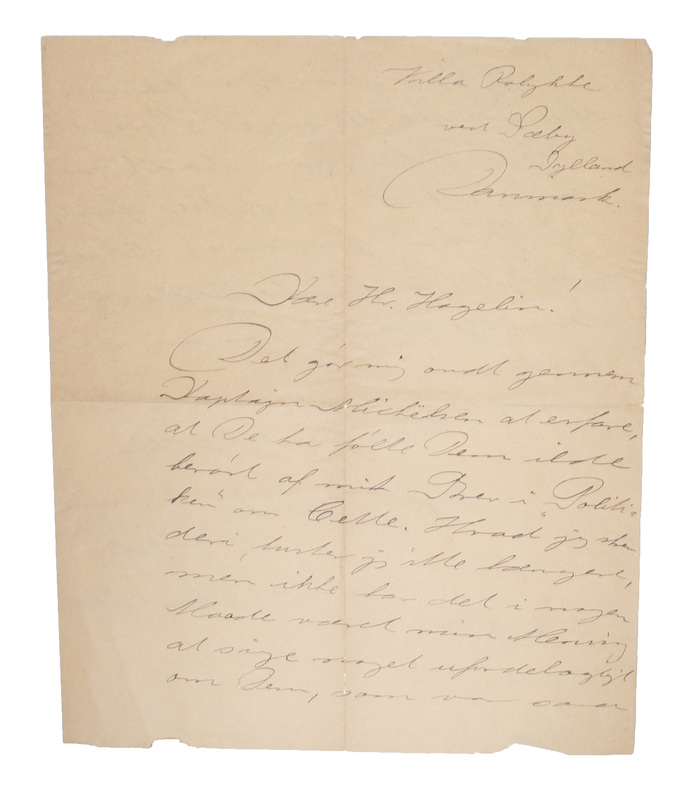
|
|
|
"WIED, GUSTAV.
Egenhændigt brevkort med udskrift ""Hr. Dr. phil. Paul Levin.."" dateret 24-XII-9.
Kastellet, (Roskilde), 1909. Postkort med udskrift, frimærke og poststempel. ""De bedste Jule- og Nytaars-ønsker fra Kastellet"". Kortet forside viser et foto af Wied, hans kone og deres tre børn på en stige med teksten ""2 x 2 = 5"" Både Wied og hans kone holder en cerut i hånden.
Bookseller reference : 51045
|
|
|
"WIED, GUSTAV.
Egenhændigt brevkort med udskrift ""Hr. Dr. Paul Levin..""
Kastellet, Roskilde, 1911. Postkort med udskrift, frimærke og poststempel 21.12.11. ""De bedste Jule- og Nytaars-ønsker fra Kastellet Roskilde"". På forsiden et foto af et af Wieds papirklip med titlen ""En Digter"". Her ses Wied med en stor fjerpen over ryggen slæbende på en lille Pegasus på hjul.
Bookseller reference : 51046
|
|
|
"WIED, GUSTAV.
Egenhændigt brevkort med udskrift til ""Hr. Student Hakon Wied"". dateret 31-1-08.
Kastellet, Roskilde, 1908. Postkort med udskrift, frimærke og poststempel. Wied aflyser et møde og unerskriver sig ""Hilsen !/ G.W."" Forsiden prydes af Wieds eget foto fra Kastellets tårn med Domkirken i baggrunden.
Bookseller reference : 51047
|
|
|
"WIED, GUSTAV.
Egenhændigt brevkort med udskrift til ""hr. Dr. Poul levin"", dateret 6-3-06.
Roskilde, 1906. Postkort med udskrift, frimærke og poststempel. Wied skriver på en ny komedie og spørger, om han virkelig ikke må navngive en person heri ""Roselle"" - han slutter ""S.u. omgaaende !, Hilsen Gustav Wied"". Kortets forside er en gengivelse af Wieds eget foto af ""Kastellet""
Bookseller reference : 51048
|
|
|
"WIED, GUSTAV.
Egenhændigt brevkort med udskrift ""Hr. Dr. Paul Levin..""dateret Dec. 1910.
Kastellet, Roskilde, 1910. Postkort med udskrift, frimærke og poststempel 23.12.10. En Jule-og Nytårshilsen ""fra/ Familien/ Wied"". På postkortets forside er reproduceret Wieds egen forografiske gengivelse af hans besynderlige ""Min egen Pegasus"".
Bookseller reference : 51049
|
|
|
"HAMSUN, KNUT.
Originalt fotografi med egenhændig datering af i Hansuns hånd på bagsiden. - [ORIGINAFOTOGRAFI AF NORDENS LITTERÆRE GIGANT]
(1929). 14,3 x 10,4 cm. Monteret på pap (14,8 X 11 CM.) og med fotografens blindtrykte enerets-signatur i nederste højre hjørne (""Wilse/ ENERET""). Det prægtige fotografi af Hamsun son 70-årig ferestiller forfatteren frontalt, i fuld figur og nydeligt klædt i tredelt jakkesæt og med hat, siddende på en bænk, med en stok i den ene hånd, liggende over bægge ben, og en pibe i den anden hånd. Fotografiet er med al sandsynlighed taget udenfor på Nørholm. Der er rester af lim i venstre nedre kant på forsiden, ellers er fotografiet i glimrende stand. På bagsiden er skrevet i blyant, i Hamsuns egen, en anelse rystende, hånd: ""(Photo 1929)"".
Bookseller reference : 55456
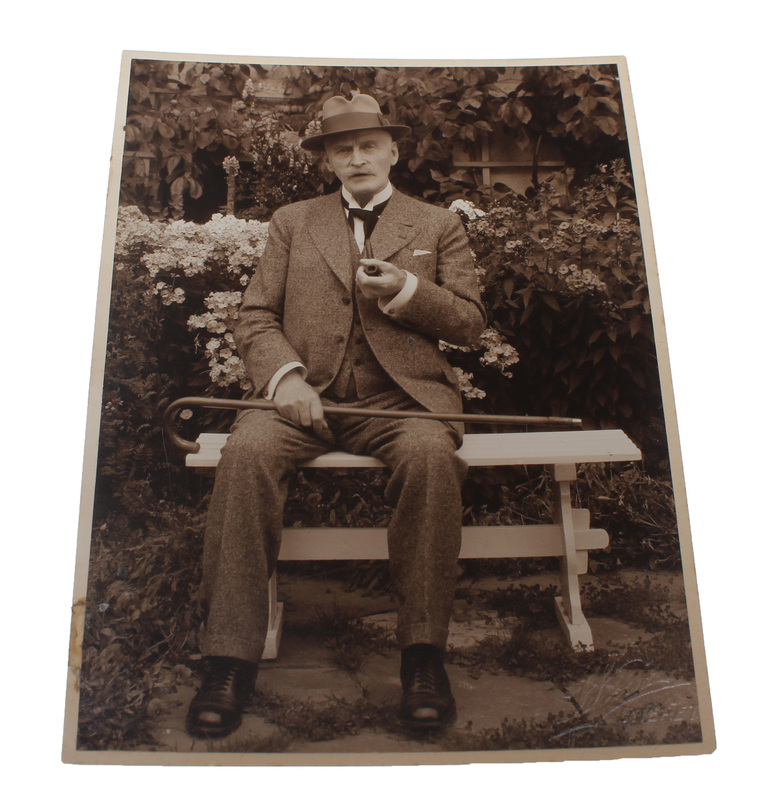
|
|
|
"HOLST, H.P. - MED EGENHÆNDIGT BREV.
Den lille Hornblæser. Fjerde uforandrede Udgave.
Kjøbenhavn, Bing & Søn, 1850. Samtidigt hldrbd. Rig rygforgyldning. Holsts egenhændige brev er indsat forrest. På hans eget brevpapir, 5 linier med underskrift ""Deres hengivne/ H.P. Holst"". Takkeskrivelse for en invitation, uden addressat og datering.
Bookseller reference : 56851
|
|
|
"BØGH, ERIK - MANUSKRIPT I GAVEEKSEMPLAR.
Digte af Erik Bøgh (kalligraferet titelblad).
1842. 31 sider egenhændigt manuskript udført af forfatteren selv i form af en lille bog som gave til en veninde. På titelbladets inderside ""Med/ Taknemmelighed og Höiagtelse/ tilegnes/ Mdm Amalie Görtzen/ dette/ ""Haandarbeide""/ fra/ en/ Wen/ der hverken kan strikke, sÿe/ eller brodere./ 11te Decbr./ Forfatteren."" Gavebindet (14,5 x 9,5 cm.) er i blåt helshirt med forgyldte permer og forgyldt ornamentik. Ryg- og kantforgyldning. Indlagt i en nydelig bogæske med overtræk af marmoreret papir. Den kalligraferede titel og de 2 kalligraferede deltitler er rigt ornamenterede, den ene med en håndkoloreret tegning, alt udført af forfatteren selv.
Bookseller reference : 57682
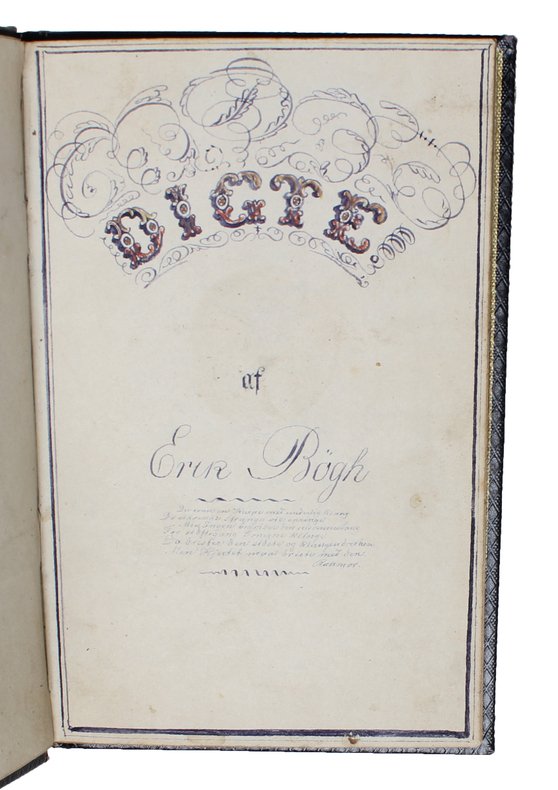
|
|
|
"KANT, IMMANUEL.
Die Religion innerhalb der Grenzen der blossen Vernunft. - [ONE OF NO MORE THAN A HANDFUL COPIES ON SPECIAL PAPER, GIVEN BY KANT TO HIS CLOSE FRIEND HASSE]
Königsberg, Friedrich Nicolovius, 1793. 8vo. In the original bluish cardboardbinding, with handwritten title to spine. Binding very neatly restored at spine and extremities. Previous owner's inscriptions to front free end-paper and title-page as well as pasted-down front end-paper. One leaf with a tiny closed tear to blank outer margin and some leaves with a single hole to the blank outer margin. Light pencil-underlinings and -markings to a few leaves. Internally clean and fresh. Printed on very heavy paper (about three times the thickness of the normal paper) and with wide margins. XX, (2), 296, (2, -errata) pp. Housed in a beautiful marbled half calf box in pastiche-style, with splendidly gilt spine and gilt morrocco title-label.
Bookseller reference : 58186
|
|
|
"CAMUS, ALBERT.
L'Été. Les essais LXVIII. - [PRESENTATION-COPY WITH A MOST SPLENDID PROVENANCE]
Paris, Gallimard, 1954. Uncut in the original printed wrappers. Excellent copy.
Bookseller reference : 58192
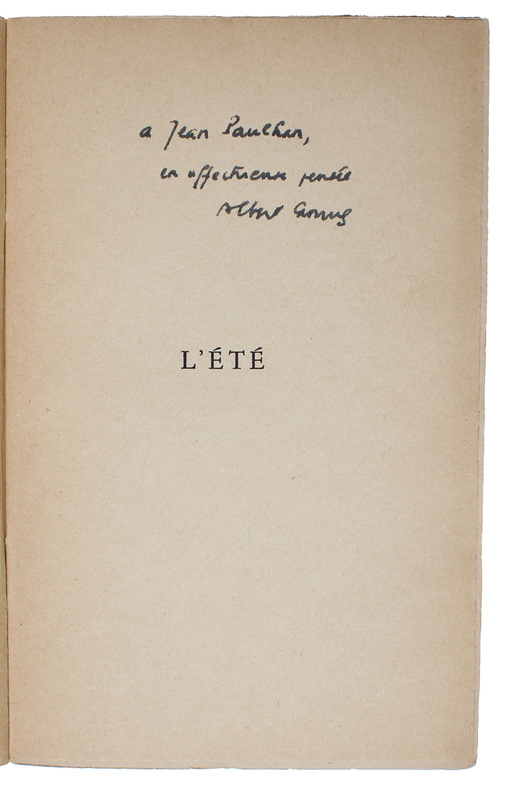
|
|
|
"CAMUS, ALBERT.
L'Été. Les essais LXVIII. - [PRESENTATION-COPY]
Paris, Gallimard, 1954. Uncut in the original printed wrappers. A very nice copy housed in a beautiful brown half morocco box with gilt lettering to spine and gilt super ex-libris to front board.
Bookseller reference : 58313
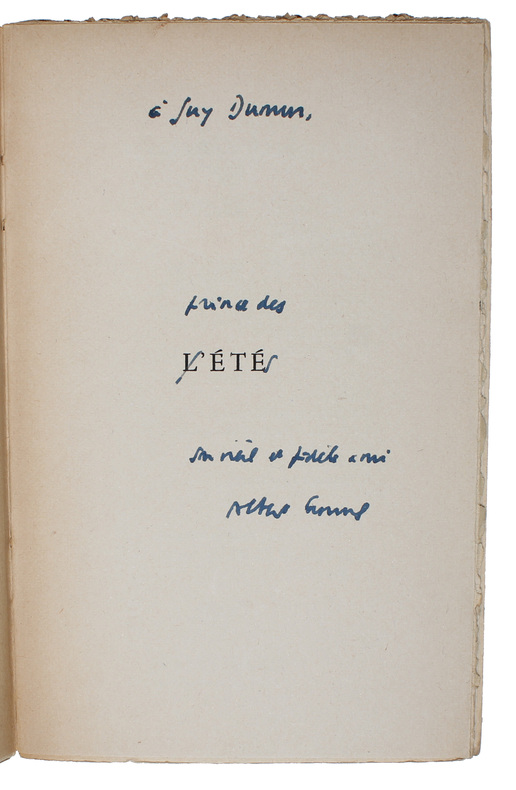
|
|
|
BALLISTIC MANUSCRIPT, FRANCE.
Cours de Balistique.
Undated, Around 1820. 4to. (22 x 18 cm.). Contemp. hcalf. Gilt spines. Titlelabel with gilt lettering. A paperlabel pasted on lower part of spine. Title-page. I-X (Table des materières),186 pp. and 6 folded MS-plates in folio with 29 geometrical figures. Written in a fine small legible hand in brown ink in French. Many mathematical formulas describing different trajectories, loads, ammunition etc., discussing and correction the theories of Gregory, Poisson, Rumford, Robins, Bezout, Borda, Legendre etc. The MS does nor unveils the name of the author. Unprinted ?.
Bookseller reference : 58756
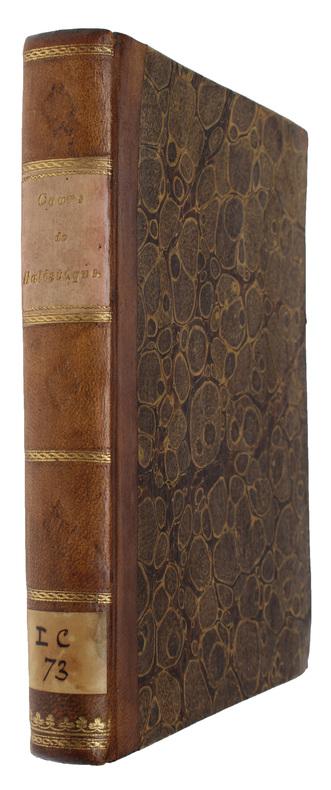
|
|
|
"BORN, MAX.
Original handwritten and signed postcard for ""Lieber Puzl"" (i.e. Puzl Born, Max Born's grandson), poststamped and postmarked, and with address in Max Born's hand. - [ORIGINAL HANDWRITTEN POSTCARD FROM MAX BORN]
Dated ""14.2.29"" (poststamped ""15.02.29""). Postcard depicting Hohenluftort Königsfeld, 763 m ü. M. bad Schwarzwald, with 12 handwritten lines on the verso as well as the address, all in Max Born's hand and signed ""Max Born"".
Bookseller reference : 58762
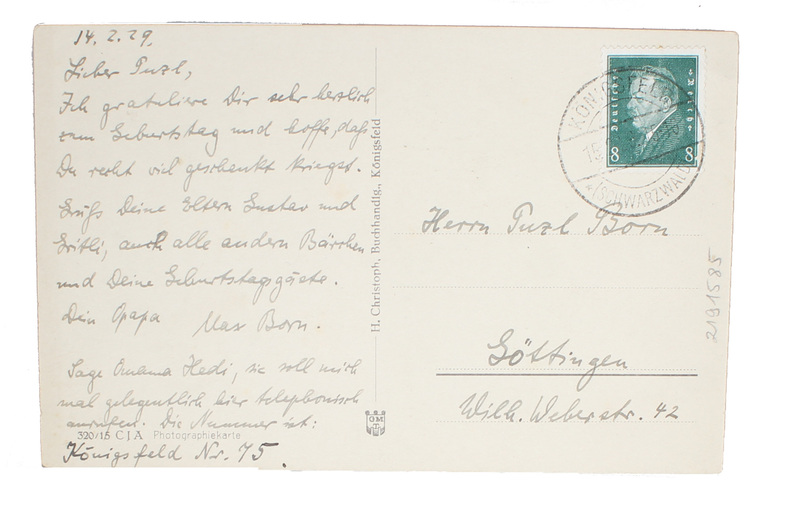
|
|
|
"NAGENS, C. R.
En kort Fremstilling af den Kongelige Sachsiske Armee. (i.e. English ""A Brief exposition of the Royal Saxon Army"") - [MANUSCRIPT ON THE ROYAL SAXON ARMY]
Helsingør, April 1857. Folio (325 x 195 mm). Manuscript in contemporary blue boards with white title-label with title in contemporary hand to top of front board. Stamp to verso of front board and first leaf. Fine and clean throughout. 32 ff.
Bookseller reference : 58776
|
|
|
"BRØCHNER, HANS.
Egenhændigt brev til ""Hr. Prof. chem. E. A. Scharling, Ephorus for Professorernes Enkekasse"" signeret ""Prof. H. Brøchner"".
Kbhvn d. 3. Marts 1866. 1 side 8vo. ""Hr. Prof. chem. E. A. Scharling, Ephorus for / Professorernes Enkekasse / Jeg tillader mig at gjøre Deres Velbaarenhed / Meddelelse om, at min Hustru, Ingeborg / Dorothea Emilie, født Ipsen, den 20de Februar / er afgaaet ved Døden. / Med Høiagtelse / Prof. H. Brøchner / Kbhvn d. 3 Marts 1866.""
Bookseller reference : 59966
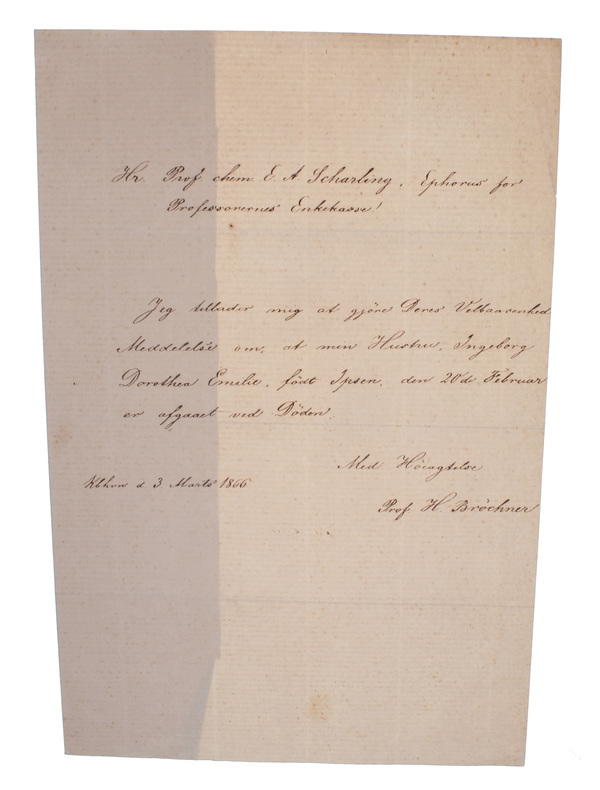
|
|
|
"RAFN, CARL CHRISTIAN.
Egenhændigt brev signeret ""C. C. Rafn.""
Kjøbenhavn, den 25de April 1863. 1 side 8vo. ""Kjøbenhavn, den 25de April 1863 / Betræffende Bogladeprisen / og ligeledes Subskriptionsprisen / paa Oldnordiske Ordbog kunde / der tages nærmere Bestemmelse, / efterat Bestyrelsens Betænkning / er indhentet. Vi maatte / jo see til at faae Bogen / udbredt. / Paa Tirsdag Eftermiddag kan / Bestemmelsen være truffen og for- / inden kunne Bøgerne ikke vel / afsendes. De ere vel heller ikke / alle heftede endnu. / Med megen Agtelse. / C. C. Rafn. / Gyldendalske Boghandling.""
Bookseller reference : 59970
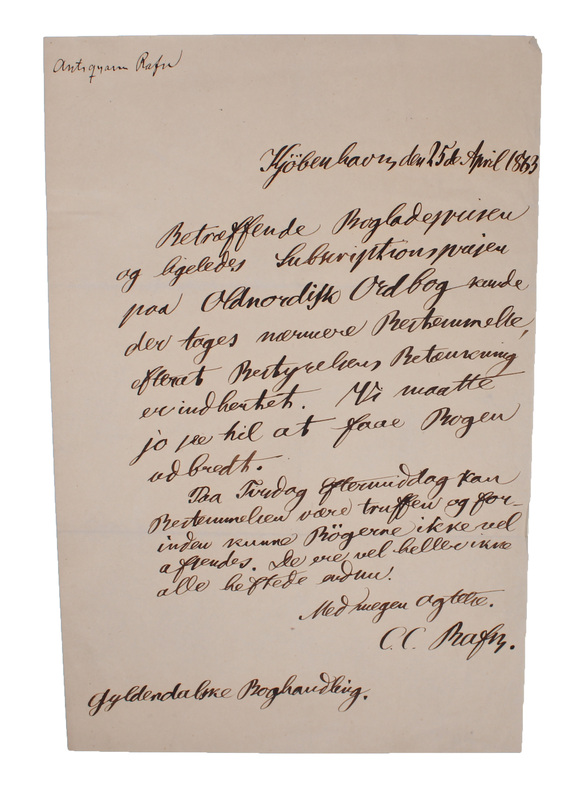
|
|
|
"PRONY, (GASPARD CLAIR FRANCOIS RICHE de).
Mécanique Philosophique, ou Analyse Raisonnée des diverses parties de la Science de l'Équilibre et du Mouvement. - [FROM NAPOLEON'S LIBRARY]
Paris, Imprimerie de la République, an VIII [i.e. 1800]. 4to. Bound in a lovely full mottled calf binding with fine, gilt ornamental borders to boards, double gilt line-borders to all edges of boards and a richly gilt spine. Spine with gilt red leather title-label and with the gilt monogram of Joséphine and Napoléon - ""JB"" - to lower spine. Neatly rebacked. With a handwritten inscription for Napoleon to title-page ""Au Citoyen Bonaparte/ premier Consul de la République francaise/ De la part du Conseil [de]/ L'Ecole Polythechnique"", with a signature underneath and the stamp of the Ecole Polytechnique. The inscription is slighly cropped at the outer margin. A bit of brownspotting here and there. (4), VII, (1), 477, (3) pp.
Bookseller reference : 60104
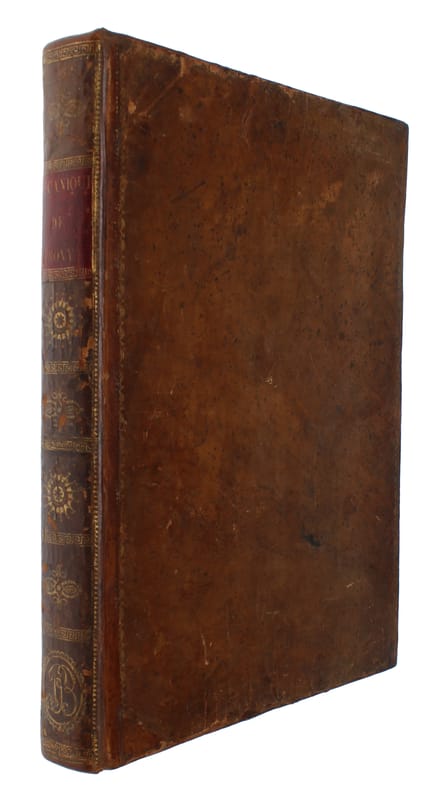
|
|
|
"COLETTE (COLETTE WILLY) [COLETTE de JOUVENEL].
Chéri. Roman. - [PRESENTATION-COPY - ON OF 175 NUMBERED COPIES]
Paris, 1920. Bound uncut with the original printed wrappers, also the backstrip, in a magnificent bright purple lambskin binding with title and author in bright, metallic lettering to spine, blue, pink, and green respectively. Triple bright metallic line-borders to boards (same three colours), inside which the remainder of the boards are covered with a large inlay of shiny, coloured leather in crocodile skin-like relief pattern. Recto and verso respectively of flyleaves covered with pink/purple suede. Housed in a chemise with purple lambskin spine with same lettering as the binding and purple cloth boards, inside grey suede, and purple full lambskin slipcase. The binding is signed Leroux (in shiny green lettering to inside of front board). A handwriiten postcard from Leroux to the previous owner of the book is enclosed. The postcard is dated 1997 and concerns the binding, including the price. The slipcase has a bit of edgewear, but the binding is near mint. Apert from a tiny tear (no loss) to the upper margin of the front wrapper, also internally near mint. Front free end-paper with a four-line inscription for ""René Baer"" signed ""Colette de Jouvenel"".
Bookseller reference : 60344
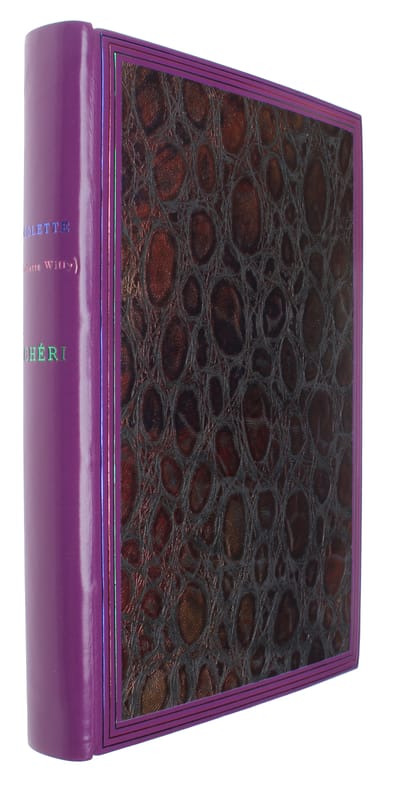
|
|
|
"HAMSUN, KNUT.
Sult. - [ASSOCIANTIONSEKSEMPLAR MED INDKLÆBET KORT FRA HAMSUN]
(København, 1888). Pænt senere (ca. 1920) halvlæderbind med forgyldt titeletiket på forperm (Anker Kyster). Læder slidt ved kanter og øvre kapitæl. Indvendig frisk. Med Max Lesters ex libris på indersiden af forpermen og Indklæbet 10 liner langt håndskrevet kort fra Hamsun til Max Lester på verso af forreste friblad, dateret ""Larvik, 12/6. 18."" Nice later (ca. 1920) half calf with gilt title-label to front board (Anker Kyster). Leather worn at edges and upper capital. Internally fresh. With Max Lester's ex libris to inside of front board and verso of front free end-paper with a visiting card from Knut Hamsun, with a 10 lines long handwritten note for Max Lester, dated ""Larvik, 12/6. 18."".
Bookseller reference : 60732
|
|
|
"ROUSSEAU, JEAN-JACQUES.
Original handwritten manuscript-leaf in Rousseau's hand constituting in a series of notes on marriage from the ""Rituel de Chartres"" (printed in Paris in 1531). - [HANDWRITTEN NOTES BY ROUSSEAU ON MARRIAGE RITUALS]
(Unsigned, and no date, but penned between 1746 and 1751). 1 leaf 4to (25,5 x 19 cm), off-white paper in fine condition. Fully penned on both recto (24 lines) and verso (5 lines).
Bookseller reference : 60957
|
|
|
"NIELSEN, CARL
Original handwritten and signed letter addressed to 'Hr Harder'.
14 - 4 - [19]07. 1 page, 8vo. ""Kjære Hr Harder! - De skal meget snart / høre fra mig. Jeg har ikke kunnet skrive / før. Min Hustru har været meget syg / de sidste Tre Uger, er bleven opereret / flere Gange. Desuden har vi af andre / Grunde ikke kunnet faa Tid at se ordentlig / paa Deres Ting. Paa Gensyn Deres / Carl Nielsen.""
Bookseller reference : 61375
|
|
|
"ESTRUP, J. B. S.
Originalt håndskrevet og signeret brev til ""Hr Kammerherre Oberst Hedemann"".
Kbhvn 8/2 [18]93. 1 side 8vo. ""Kbhvn 8/2 93 / Toldbodvei 34 / Vil De tillade mig / at foreslaae Hs Majestæt / Kongen at udnævne / Dem til Kongevalgt / Medlem af Lands- / thinget? / Med Høiagtelse / Ærbødigst / JBS Estrup.""
Bookseller reference : 61376
|
|
|
"ESTRUP, J. B. S.
Originalt håndskrevet brev til ""Hr Landsthingsmand Larsen R af D"".
Skafø, 27/10, [18]95. 2 sider 8vo. ""Jeg har tilladt / mig at sende Dem / 80 Kr paa Postanviis- / ning og beder Dem / mig at undskylde, / at jeg ikke for længe / siden har berigtiget / min Gjæld til Dem / for det smukke Væder- / lam, De har overladt / mig. Grunden / dertil er, at jeg / først nu hører af / min Søn, at / han ikke, som / jeg antog, har / berigtiget Sagen / paa mine Vegne. / Med venlig / Hilsen til Deres / Mand / Deres ærbødige / JBS Estrup.""
Bookseller reference : 61378
|
|
|
"MYNSTER, J. P.
Originalt håndskrevet brev, signeret ""Mynster"".
Kbhavn d. 24de Juli 1824. 1 side 4to. ""Disse faa Ord have en tredobbelt Bestemmelse: 1) at takke hjerteligst / for Deres venlige Tilskrivt"" 2) at mælde, at da vi i Roeskilde have adskillige / Visiter at aflægge m. v., saa kunne vi ikke, selv efter den kiøbenhavnskeste / Beregning, komme til Middagstiid. Vi bede derfor, ikke at ansee os / som Middagsgiester, da vi nok i Ringsted finde Livets Fornødenhed, / om man endog der er mindre vel akkommoderet. Vi komme saals. / der først engang om Eftermiddagen - naar, vil beroe paa Vind og / Veir 3) at takke meget fra den unge Velærværdighed, som naturligviis med megen Fornøjelse modtager Deres venskabelige Invi- / tation, naar han kun ikke generer for meget.""
Bookseller reference : 61379
|
|
|
"THOMSEN, VILHELM.
Originalt håndskrevet postkort til ""G.E.C. Gads Universitetsboghandel"", signeret ""Vilh. Thomsen"".
Vedbæk, 27/6 [19]04. Postkort. 5 linjer. ""Jeg beder Dem skaffe mig: / A. Dirr, Grammatik der modernen / georgischen Sprache. Wien u. Leipzig / Hartleben. / Ærb. / Vilh. Thomsen.""
Bookseller reference : 61381
|
|
|
"SIBBERN, FREDERIK CHRISTIAN.
Originalt håndskrevet brev til ""Herr Licent: Lind"", signeret ""Sibbern"".
2 sider 8vo. på godt skrivepapir.
Bookseller reference : 61384
|
|
|
MØLLER, NIELS.
Annabella og andre Digte.
1931. Lille 4to. M. orig. for- og bagomsl. i hldrbd. Forreste fals revnet.
Bookseller reference : 640
|
|
|
"KRUSENSTERN - DANISH MANUSCRIPT TRANSLATION
Beretning til Kaartet over Sonda Stræde samt Batavia Rehd (Translated from the French: ""Mémoire sur une carte du détroit de la Sonde et de la rade de Batavia"" - [DANISH MANUSCRIPT TRANSLATION OF KRUSENSTERN'S ""STRAIT OF SUNDA"", INCLUDING THE MAP]
København, 1820 (Original work published St. Pétersburg, 1813) 4to (190 x 258 mm). In later half cloth. Gilt lettering and stamp to front board. Two stamps to title-page. Manuscript in brown ink by Danish Rear Admiral Lövenørn. Fine and clean with text in very good and legible condition. (6), 32 pp. + coloured manuscript map of Strait of Sunda. Copy of Krusensterns 1813-map. (590 x 460 mm)
Bookseller reference : 58819
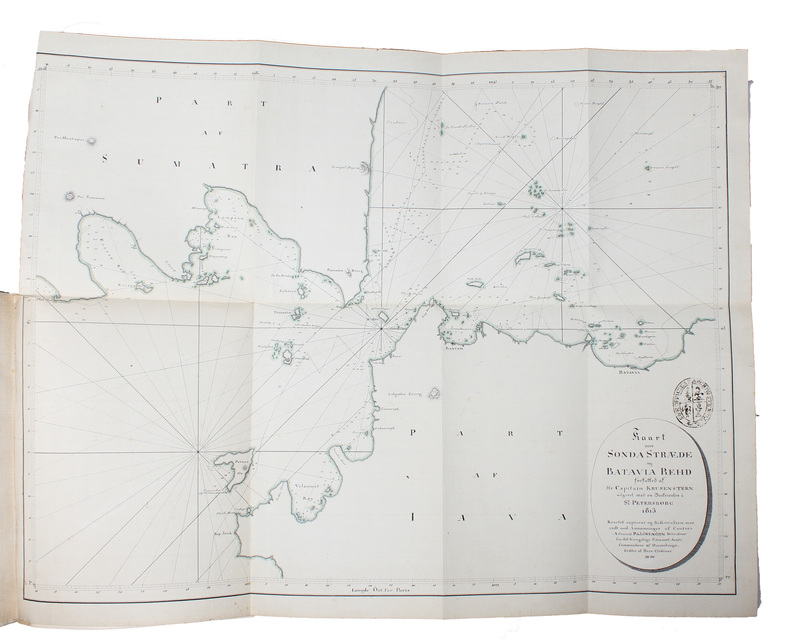
|
|
|
"CAMUS, ALBERT.
L'Exil et le Royaume. nouvelles. - [PRESENTATION-COPY FOR HENRY HELL]
(Paris), Gallimard, (1957). Bound with the original printed wrappers in beautiful, elegant emerald green full morocco binding with gilt line-decoration in various heights and distances to boards and spine as well as vertical gilt lettering to spine. Top edge gilt. Binding signed A. Coutret. Wrapper a bit soiled, mostly the back wrapper. Otherwise very nice and clean. Paper evenly browned due to the paper quality. Gilt super ex-libris to inside of front board.
Bookseller reference : 58824
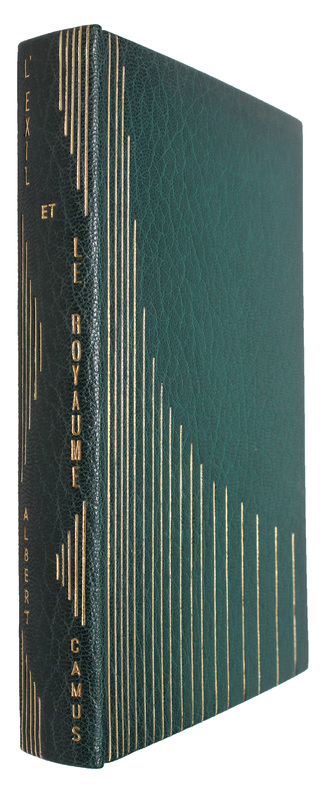
|
|
|
"LANGE, H. O.
To egenhændigt breve fra H. O. Lange, det første til H. Olrik, det andet til Kunstakademiets forvalterkontor. - [TO EGENHÆNDIGE OG SIGNEREDE BREVE FRA H. O. LANGE.]
Gjentofte, 17/3, (19)10 + (København), 20/3 1918. 1) Tvær-8vo, 5 linier: ""Kjære Hr. Professor! / Tak for Deres Brev med Anmodningen om en Anmeldelse af Kierkegaards Papirer. Hvis den skal skrives i Løbet af de første to Maaneder, tør jeg ikke love det. Men hvis det maa vente, saa haaber jeg at kunne sende Dem en. / Deres hengivne / H. O. Lange.""2) 8vo, 4 linier, skrevet på brevpapir fra ""Bibliotheca Regia Hafniensis"": ""Beklagende ikke at kunne komme / sender jeg hermed Adgangskortet tilbage. / Ærbødigst / H. O. Lange. / Til / Kunstakademiets Forvalterkontor.""
Bookseller reference : 58934
|
|
|
"NODIER, CHARLES - LETTER TO ALEXANDRE DUMAS.
Autograph letter signed ""Charles Nodier"" written out to his friend Alexandre Dumas ""Mon cher ami,...""
Undated, around 1836. 1 leaf 8vo. on light-blue paper. 16 lines and signed ""Tout á vous et de coeur/ Charles Nodier"" The letter seems to deal with Alexander Dumas' novel ""Voyages de Gabriel Payot"". On verso of the letter is transscribed in Nodier's hand ""Monsieur Alexandre Dumas,/ cour d'Orleans No 3./ Paris"". Marks after folding. Faint scattered brownspots.
Bookseller reference : 59408
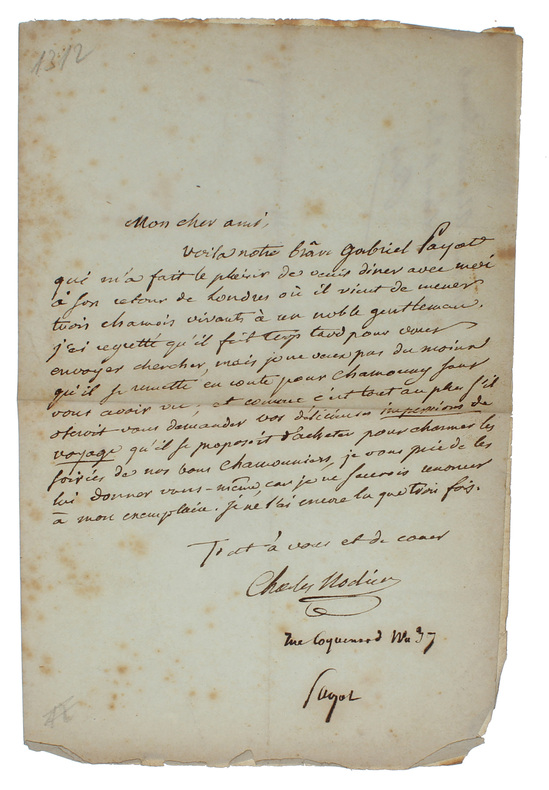
|
|
|
HANOTAUX (Gabriel).
Deux lettres autographes signées.
Sur feuillets doubles (13,5 x 21 cm), à en-tête de la "Société de l'Histoire Nationale".Toutes les deux adressées à Marcel Génermont, Architecte des Bâtiments de France, Président de la Société d'Emulation du Bourbonnais...
Bookseller reference : 614
|
|
|
CHABROL (Jean-Pierre).
LETTRE AUTOGRAPHE SIGNEE ET ILLUSTREE.
1 feuillet 21 x 27 cm, papier pelure, daté du 8 février 1965, expédié de Saint-Cyr sur Morin (enveloppe jointe). Large signature ornée d'un dessin en rouge (stylo et crayon).
Bookseller reference : 7552

|
|
|
CHABROL (Jean-Pierre).
Lettre autographe signée.
1 feuillet recto, (21 x 27cm). Daté de Saint-Cyr-sur-Morin le 3 août 1964, adressé à un ami dentiste du Gard. Enveloppe d'expédition conservée.
Bookseller reference : 7589

|
|
|
ADAM (Juliette, née LAMBERT). 1836-1936.
DEUX LETTRES AUTOGRAPHES.
Bookseller reference : 9271
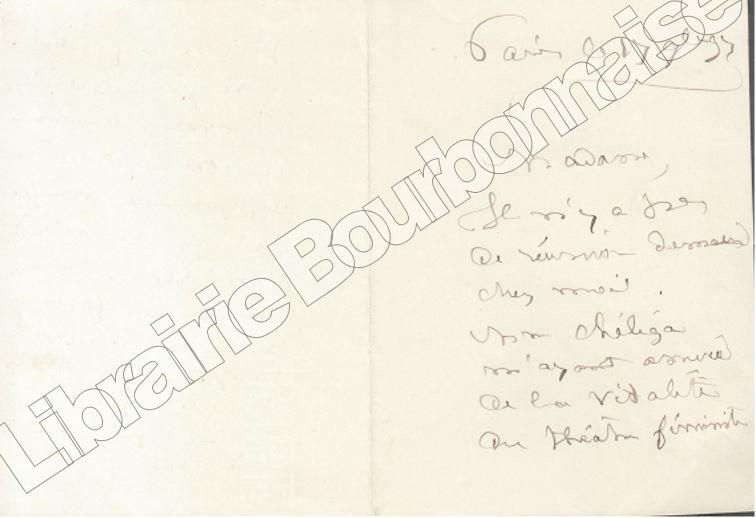
|
|
|
DORAT (Claude-Joseph). 1734-1780. Poète et romancier français
L.A.S. à Antoine Léonard THOMAS de l'Académie Française.
1 page in-4 ( 23 x 19 cm), s. l, n. d. [1775]. Trace de cachet de cire rouge au dos. Très bon état.
Bookseller reference : 9514

|
|
|
DES ESSARTS (Emmanuel LANGLOIS). 1839-1909. Professeur de lettres à la Faculté de Clermont, auteur d'ouvrages sur la littérature et de recueils de poèmes.
3 L.A.S. Clermont-Ferrand, 10 décembre 1881 - 1 et 4 février 1882, 6 pp. in-12. (15,5 x 9,5 cm) Au même correspondant, il évoque sa collaboration à la revue Fantaisie. Des rousseurs.
Bookseller reference : 9783
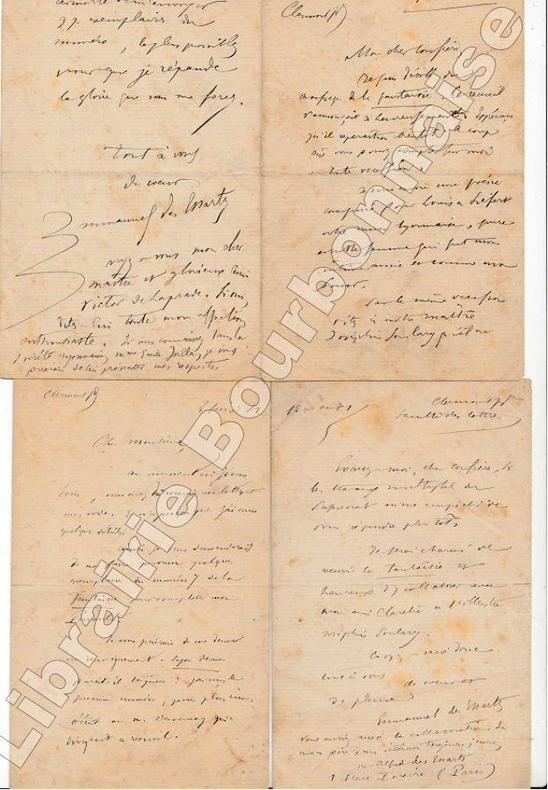
|
|
|
LAPRADE (Victor de).
Lettre autographe signée, à son éditeur (Michel Lévy), datée d'Aurillac, 25 août 1852 ; in-8, 2 pages et demie, sur papier vergé bleu.
Bookseller reference : 9802
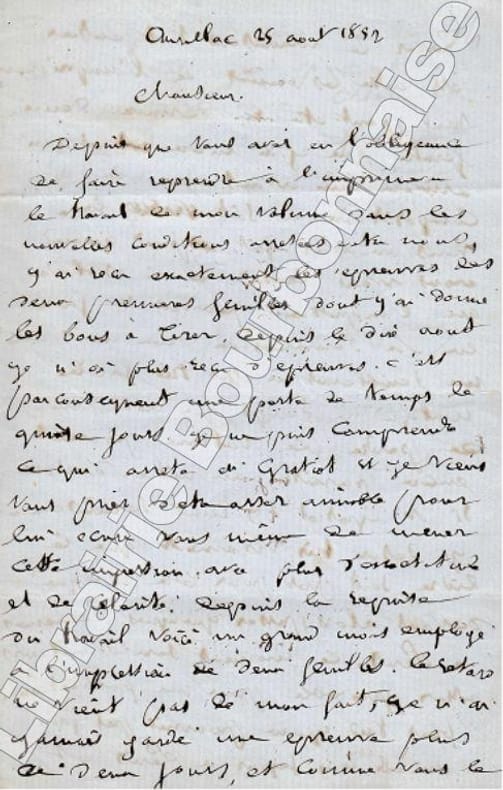
|
|
|
GANNE (Louis).
Carte de visite autographe signée à l'entête du Casino de Monte Carlo - Concerts Louis Ganne.
Carte 10,8 x 13,8 cm, sur laquelle le compositeur et chef d'orchestre donne une entrée permanente à ses concerts qui ont lieu tous les jours à 16h30 à lIinternational porting Club.
Bookseller reference : 10198
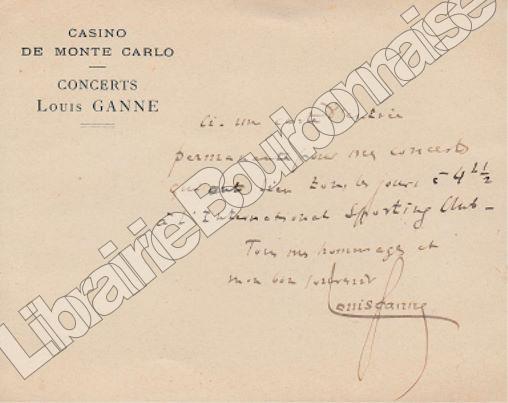
|
|
|
BANVILLE (Théodore de).
Odes funambulesques. Avec un frontispice gravé à l'eau-forte par Braquemond d'après un dessin de Charles Voillemot.
Alençon, (Paris sur la couverture), Poulet Malassis et Broise, 1857 ; in-12. Frontispice-2ff.-XX-243pp.-1 planche dépliante de musique. Demi-veau vert, dos lisse, titre et filets dorés. Couvertures conservées. Vignette ex-libris sur le contreplat sup. Bel exemplaire.
Bookseller reference : 11579

|
|
|
BEAUMARCHAIS (Pierre-Augustin Caron de).
La Folle Journée, ou le Mariage de Figaro, comédie en cinq actes, en prose, par M. de Beaumarchais. Représentée pour la première fois par les Comédiens français ordinaires du Roi, le mardi 27 avril 1784.
[Kehl], De l'Imprimerie de la Société littéraire-typographique ; et se trouve à Paris, chez Ruault, 1785 ; in-8. LI-(1)-199 pp.-(1). 10 planches hors-texte. Maroquin rouge, dos à nerfs richement orné, encadrements de triples filets dorés sur les plats, doubles filets sur les coupes, dentelle dorée sur les chasses, tranches dorées. (Rel. Chambolle-Duru). Bel exemplaire à grande marges, présentant cependant un coin émoussé et des frottements en tête des deux charnières. Conservé sous chemise et étui avec dos de maroquin brun, titre doré.
Bookseller reference : 12484
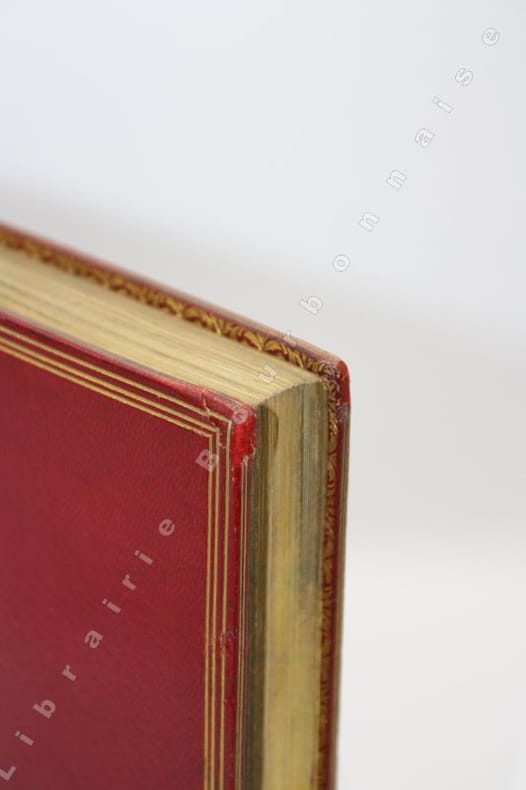
|
|
|
DIDEROT (Denis).
Lettre adressée à un magistrat sur le commerce de la librairie. Introduction et notes marginales par Bernard Grasset.
P., Grasset, 1937 ; in-8, broché. 171 pp.-1 f. Couverture papier rempliée imprimée en brun et noir, dos long, non coupé et non rogné. Bon état.
Bookseller reference : 12747
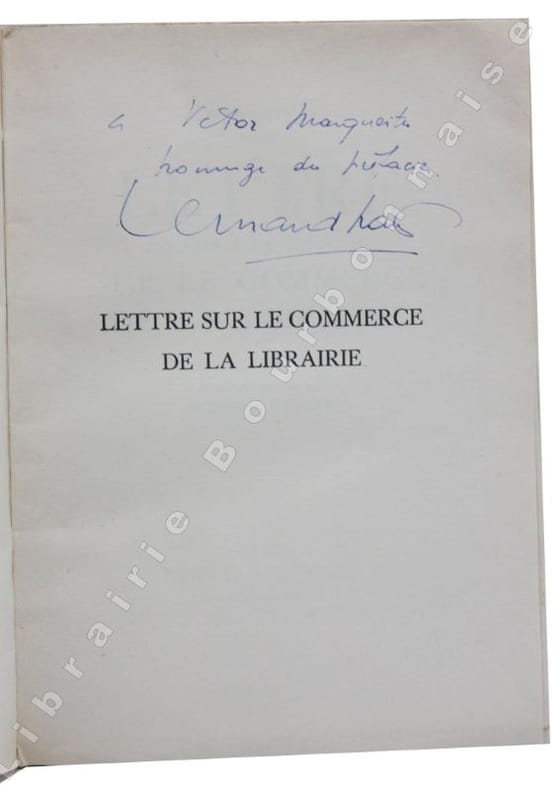
|
|
|
SCHURICHT (Carl).
Lettres autographes :
Bookseller reference : 13183
|
|
|
ANISSON-DUPERON (Hippolyte). 1776-1852. Député du Puy-de-Dôme, Directeur de l'Imprimerie Nationale, ami de Montlosier, époux de Sophie de Barante fille de Claude Ignace.
5 L.A.S. adressées au Comte de Montlosier, entre le 10 novembre 1830 et le 21 mars 1832, dont 4 avec adresse et marque postale.
Bookseller reference : 13187
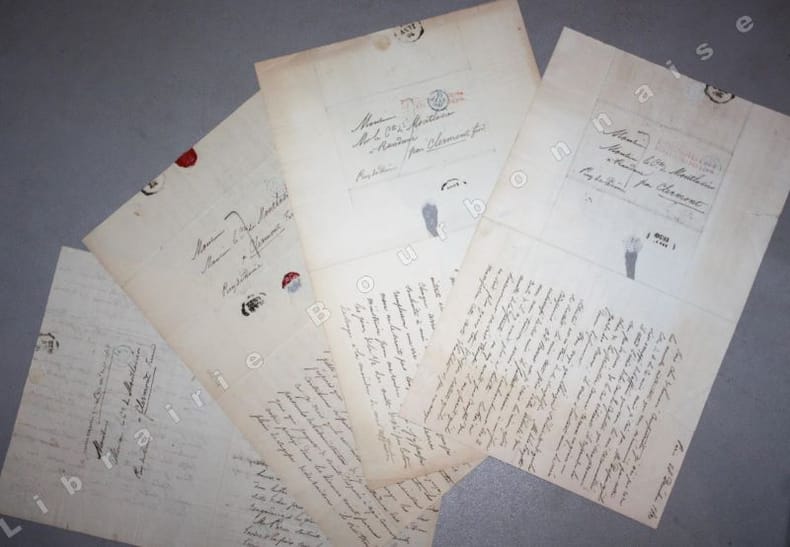
|
|
|
CHAZERAT (Charles-Antoine-Claude de). 1728-1824. Dernier Intendant d'Auvergne.
4 pièces imprimées signées. 1 pièce manuscrite signée avec 3 lignes de sa main - 2 pièces imprimmées concernant M. de Chazerat.
Bookseller reference : 13188
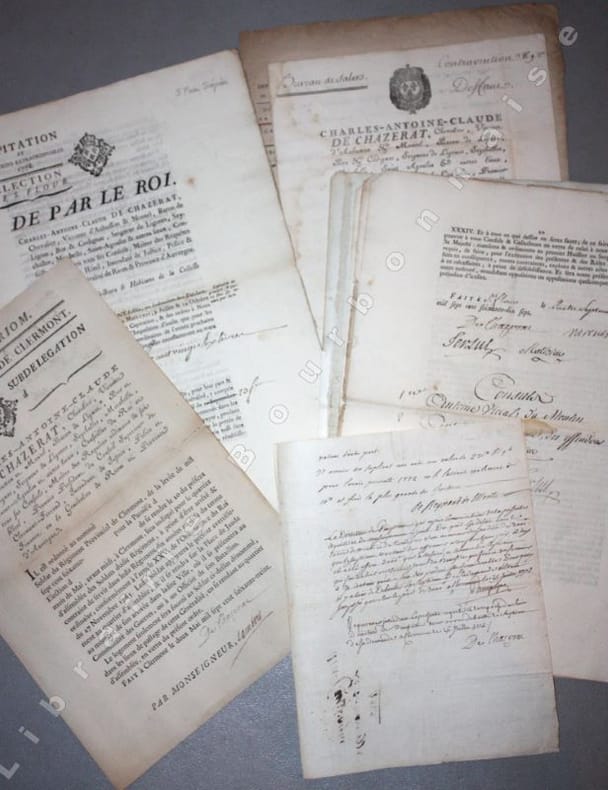
|
|
|
TRUDAINE (Daniel Charles).
Lettre autographe signée.
1 page in-8 manuscrite et signée de la main de l'Intendant d'Auvergne ; à Clermont le 14 juillet 1733, adressée à M. Lafont (sans doute Lafont de Saint-Marts, qui fut longtemps subdélégué de la généralité de Riom à Issoire).
Bookseller reference : 13332

|
|
|
HARTUNG (Hans).
Signature autographe au bas d'une lettre tapuscrite.
Antibes le 24 juin 1976, 2 pages A4 dactylographiées, à Mademoiselle F... de la S.E.P.E.M. - R.P., avec la signature manuscrite du peintre, avec enveloppe (A4) d'expédition.
Bookseller reference : 13452

|
|